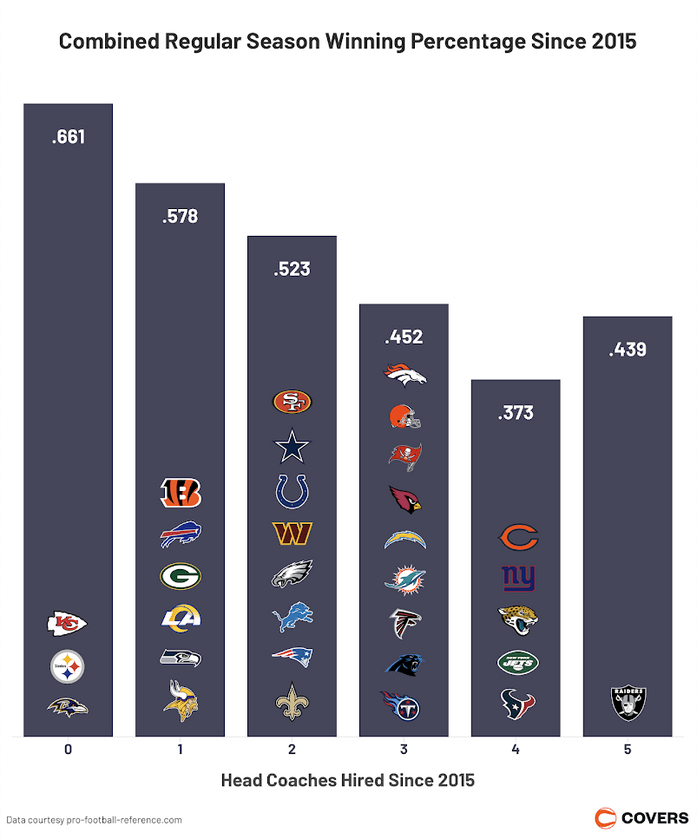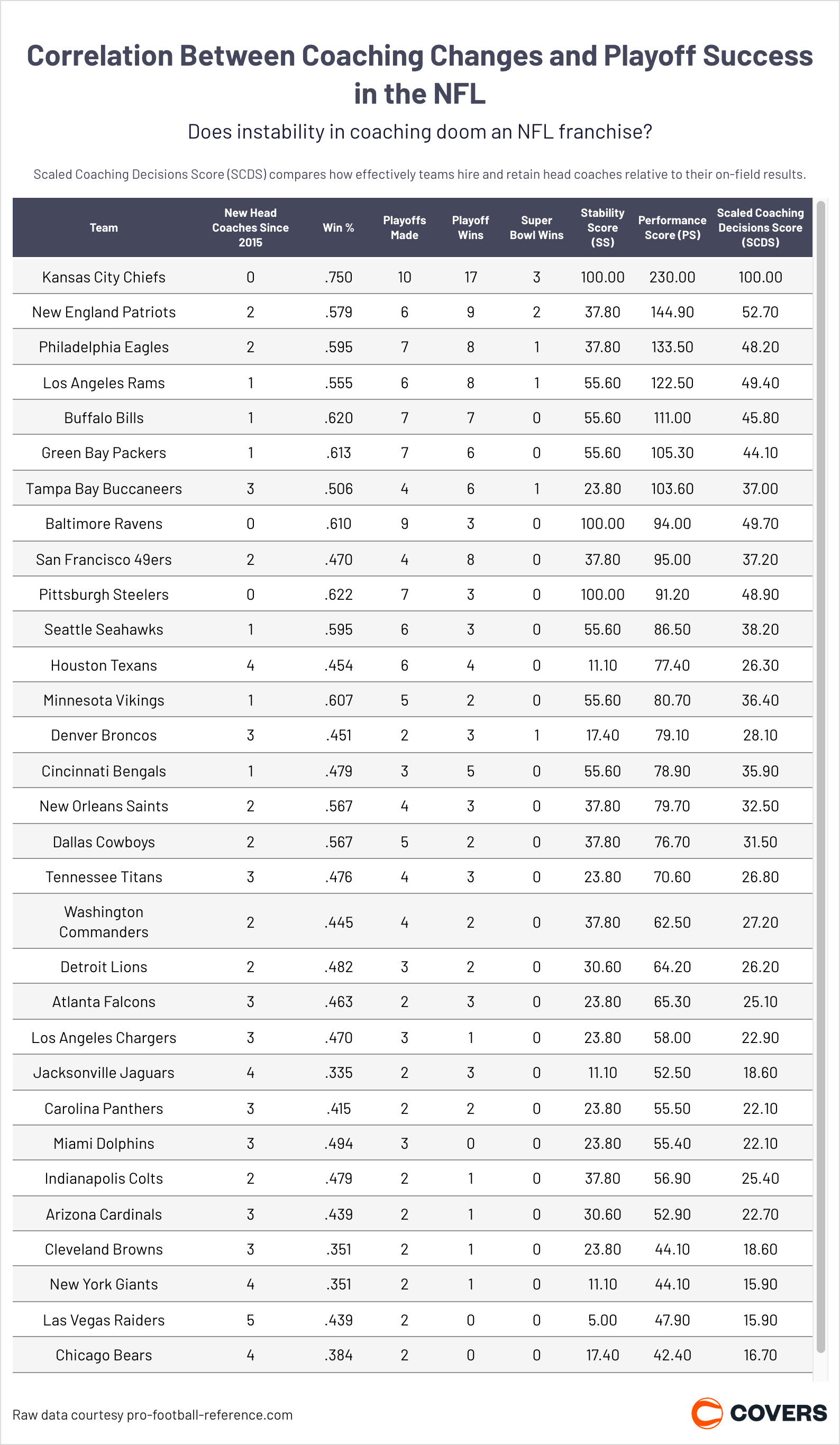Success in the NFL, according to fans and most owners, is largely a game of ‘what have you done for me lately?’ Though teams proudly display decades-old Lombardis and hang banners that’ve seen more presidents in office than any player on their roster, what ultimately matters to most franchises is winning now.
And when it comes to winning in the NFL, there's one person whose shoulders the responsibility lies solely upon. No, we're not talking about the billionaire owners. Most haven't quite embraced Harry Truman’s ‘The Buck Stops Here’ attitude. We're talking about the league's sacrificial lambs, aka head coaches.
Every year on Black Monday, the first Monday after the regular season, a handful of teams decide it's time for a coaching change to hopefully ensure the franchise’s future success. Since 2015, NFL teams have cycled through 85 head coaching hires, with results ranging from Super Bowl rings to organizational freefall.
By analyzing win-loss records, playoff success, and coaching turnover, clear patterns emerge: stability breeds contention, instability fuels dysfunction, and a single transformative hire can rewrite a team’s destiny.
Key Takeaways
- Stability begets success: Teams like the Chiefs, Ravens, and Steelers have maintained high winning percentages by retaining coaches for 10+ years.
- High turnover = high risk: Frequent firings (e.g., Raiders, Giants, Jets) lead to organizational rot.
- Transformative hires matter: McVay (Rams), McDermott (Bills), and Reid (Chiefs) prove one great coach can redefine a franchise.
- Playoff success requires elite coaching: Teams with multiple playoff wins (Chiefs, Eagles) had coaches who made key roster moves in critical moments.
- Teams with frequent coaching changes often cycle through new hires without addressing systemic issues.
Stability Score (SS)
We measure stability by how frequently teams hire or fire head coaches. More hires/fires typically suggest poor hiring decisions or short‐term thinking, leading to lower stability.
SS = 100 x (1 ÷ (1 + (Head coaches hired since 2015 + Head coaches fired since 2015)))
Performance Score (PS)
Reflects the team’s overall success under recent coaches. It uses regular-season winning percentages, playoff appearances, playoff wins, and Super Bowl wins to assign a performance value.
PS = (Winning percentage × 100) +2 × (Playoff appearances since 2010) +5 × (Playoff wins since 2015) +15 × (Super Bowl wins since 2015)
Coaching Decisions Score (CDS)
Blends stability and on-field performance into one overall metric. Compares how effectively teams hire and retain head coaches relative to their on-field results.
CDS = 0.25 × SS + 0.75 × P
Scaled Coaching Decisions Score (SCDS)
This is the same as the Coaching Decisions Score. But it’s scaled on a 100-point curve for easier comparison.
SCDS = (CDS / CDSmax) * 100
Stability can be a tricky concept in today’s NFL, where a single losing streak often places a coach firmly on the hot seat. Yet some franchises have managed to create a template for consistent coaching decisions that lead to on-field success year after year, while others continually throw new ideas (or coaches) at the wall to see what sticks. When looking over the Coaching Decisions Score (CDS) index—which blends a team’s ability to retain coaches (Stability Score) with their on-field results (Performance Score)—we notice stark differences in how franchises hire and fire their head coaches, and how effectively those moves translate to wins.
Enjoying Covers content? Add us as a preferred source on your Google account
Chiefs, Steelers, Ravens: The Models of Stability
The Kansas City Chiefs have become the shining example of finding the right coach and sticking with him. Since Andy Reid’s hiring in 2013, the Chiefs have boasted a league-best .750 winning percentage, 10 playoff appearances, and three Super Bowl victories. As such, Kansas City boasts an astounding Scaled Coaching Decisions Score (SCDS) of 100. The Chiefs’ consistency under Andy Reid has produced inarguably the best-run organization of the past decade.
They’re not alone in the upper echelon of stability. The Steelers haven’t made a change at head coach since 2007, and have recorded a strong .622 winning percentage with seven postseason trips over the past decade. Their division rival, the Baltimore Ravens led by John Harbaugh, maintains a .610 mark with nine playoff appearances in the same span. While neither Baltimore nor Pittsburgh has equaled the Chiefs’ Super Bowl haul since 2015, their unwavering approach to coaching is notable.

The Other Side of the Coin
Elsewhere, some teams keep the revolving door spinning, much to the chagrin of die-hard fans. The New York Jets, with four hires since 2015, live near the bottom of the coaching decisions hierarchy. Their .341 winning percentage and zero playoff appearances in that period have yielded an SCDS of 14.2, one of the worst in the league. Organizational instability and drama among ownership are clear indicators of a franchise in perpetual chaos.
Close behind are the Las Vegas Raiders, who made five head coaching hires in that same window. Despite managing two playoff berths since 2015, their .439 winning percentage and zero postseason wins are major drags on their Performance Score and the enthusiasm of their fans. Perhaps this is why their home stadium is largely filled with visiting fans stopping by while in Vegas.
Also lurking in the depths of despair are long-suffering franchises like the Giants, Bears, Jaguars, and Browns. Each has cycled through four head coaches since 2015, and each posts a sub .400 winning percentage period in the same period. The Giants, for example, sit at a .351 clip with only one playoff win to show for their efforts. Chicago is a .384 team with zero postseason victories. Jacksonville’s postseason runs have been fleeting, and the Browns, who ended a long playoff drought in 2020, remain at the bottom of the consistency charts.
An Exception to the Rule
Home of the Brotherly Shove, Philadelphia has pushed its way to success in recent years despite two coaching changes in the decade. Both have taken the Eagles to the Super Bowl, and since-fired head coach Doug Pederson brought home Philly’s first ring at Super Bowl LII. The Eagles have the NFC’s most regular season wins (97) since 2015 and lead the conference with seven postseason appearances.
So Who’s to Blame?
What’s another thing the Chiefs, Ravens, and Steelers, the league’s poster boys for consistency, all have in common? You virtually never hear about meddling or getting involved in the team’s day to day. Verbose, egotistical owners can be a true poison to an NFL franchise. Just look at the ownership behind the NFL’s most turbulent coaching records, like Mark Davis’ Raiders, Woody Johnson’s Jets, or David Tepper’s Panthers.
While the head coach is usually a team’s most visible talking head, the responsibility ultimately falls on NFL owners to cultivate an environment where a head coach is given the time needed to build a cohesive, team while at the same time being accountable for their hiring decisions. It’s clear that stability often translates to success on the field, but when stability morphs into sustained mediocrity, it should trigger tough reassessments of leadership choices. Effective owners know how to strike a delicate balance of investing in a coach’s long-term vision and granting the space for development, while not shying away from making necessary changes when their team consistently falls short.





















